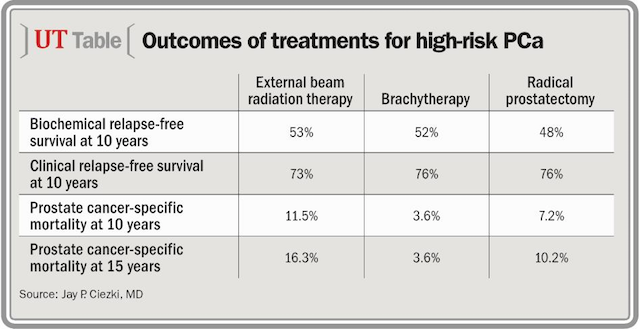Article
Modalities for high-risk PCa yield similar outcomes
Treatment options for high-risk prostate cancer perform similarly. In a single-institution study, radical prostatectomy was associated with worse biochemical failure, less clinical failure, and superior prostate cancer-specific mortality compared with radiation therapy and brachytherapy, reported Jay P. Ciezki, MD, at the 2016 Genitourinary Cancers Symposium in San Francisco.
San Francisco-Treatment options for high-risk prostate cancer perform similarly. In a single-institution study, radical prostatectomy was associated with worse biochemical failure, less clinical failure, and superior prostate cancer-specific mortality compared with radiation therapy and brachytherapy, reported Jay P. Ciezki, MD, at the Genitourinary Cancers Symposium in San Francisco.
More on PCa: Prostate biopsy-related infections raise transfusion risk
“If you look at biochemical relapse-free survival, clinical relapse-free survival, or prostate cancer-specific mortality, there’s not much that’s different amongst the lot,” said Dr. Ciezki, a radiation oncologist at Cleveland Clinic. “The reason it’s potentially surprising is because there has been ‘onco-lore,’ more than ‘onco-data,’ saying that when you have high-risk prostate cancer and you’re going to use brachytherapy, you have to combine it with external beam.”
Read: Data offer new insight on HIFU’s use in low-risk PCa
His group looked at 2,736 high-risk prostate cancer patients treated at Cleveland Clinic from 1996 to 2012, who were part of an inception cohort study. High-risk prostate cancer was defined as clinical stage T3, a biopsy Gleason score of 8 to 10, a PSA value >20.0 ng/mL, or the presence of two intermediate-risk factors (clinical stage T2b or T2c, biopsy Gleason score of 7, PSA >10.0 ng/mL).
Next: Outcomes compared among EBRT, BT, RP
Outcomes were compared among the three main treatment options for prostate cancer: external beam radiation therapy, brachytherapy, and radical prostatectomy.
Also see: Use of observation for PCa varies widely among urologists
Biochemical failure was defined as a post-radical prostatectomy PSA value ≥0.4 ng/mL and a post-radiotherapy PSA value ≥2.0 ng/mL above the PSA nadir value. Clinical failure was defined as either local failure (recurrence of cancer within the prostate or prostate bed) or distant failure (cancer metastasized to another site of the body). Cause-specific survival was defined as death from prostate cancer. Patient follow-up data were collected from a review of their electronic medical record and were entered into a database.

“The majority of patients who underwent external beam radiation therapy were treated prior to 2002 because of our growing preference for radical prostatectomy and brachytherapy over time,” said Dr. Ciezki.
Radical prostatectomy was performed in 54% of patients (n=1,487), external beam radiation therapy in 27% (n=734), and brachytherapy in 19% (n=515). No patient received external beam radiation therapy plus brachytherapy, and 44% received androgen deprivation therapy.
The biggest difference among patient groups was in clinical stage. About one-fourth (25.8%) of patients who underwent radical prostatectomy had clinical stage T3 compared with 13.8% undergoing external beam radiation therapy and 0.4% undergoing brachytherapy.
Have you read: Transfusion’s effects examined in RP patients
Median follow-up was 4.6 years overall: 3.8 years for patients undergoing radical prostatectomy, 7.7 years for those receiving radiotherapy, and 4.1 years for those who were treated with brachytherapy.
Next: RP patients at higher risk of PSA failure
RP patients at higher risk of PSA failure
Biochemical relapse-free survival at 10 years was 53% in the external beam radiation group, 52% in the brachytherapy group, and 48% in the radical prostatectomy group. On multivariable analysis, radical prostatectomy patients were at higher risk for biochemical failure versus external beam (hazard ratio [HR]: 1.316; p=.008).
Recommended: Study finds prostate Ca clones trackable by fusion biopsy
Clinical relapse-free survival at 10 years was 73% in the external beam radiation group, 76% in the brachytherapy group, and 76% in the radical prostatectomy group. On multivariable analysis, brachytherapy patients (HR: 1.771; p=.0029) and external beam patients (HR: 1.353; p=.0030) were at higher risk for clinical failure than radical prostatectomy patients.
Prostate cancer-specific mortality at 10 years was 11.5% in the external beam radiation group, 3.6% in the brachytherapy group, and 7.2% in the radical prostatectomy group, and at 15 years, it was 16.3% in the external beam radiation group, 3.6% in the brachytherapy group, and 10.2% in the radical prostatectomy group.
On multivariable analysis, external beam patients (HR: 1.511; p=.0007) were at higher risk for prostate cancer-specific mortality compared to radical prostatectomy patients, while there was no significant difference between radical prostatectomy and brachytherapy (HR: 1.173; p=.6366).
All multivariable analyses were adjusted for clinical stage, biopsy Gleason score, pre-treatment PSA, and duration of ADT.
“Clinical stage doesn’t seem to track very much with the outcomes-a little but not quite as strongly as Gleason score, for which there was no real difference between the modalities, and that’s one of its strengths,” Dr. Ciezki said. “One of the major prognostic variables-Gleason score-was pretty much the same across all of them.”
More from Urology Times:
AS success rate strong in appropriate PCa patients
Greater long-term side effect risk with intermittent ADT
No link between PDE-5 use, prostate Ca recurrence
Subscribe to Urology Times to get monthly news from the leading news source for urologists.

















